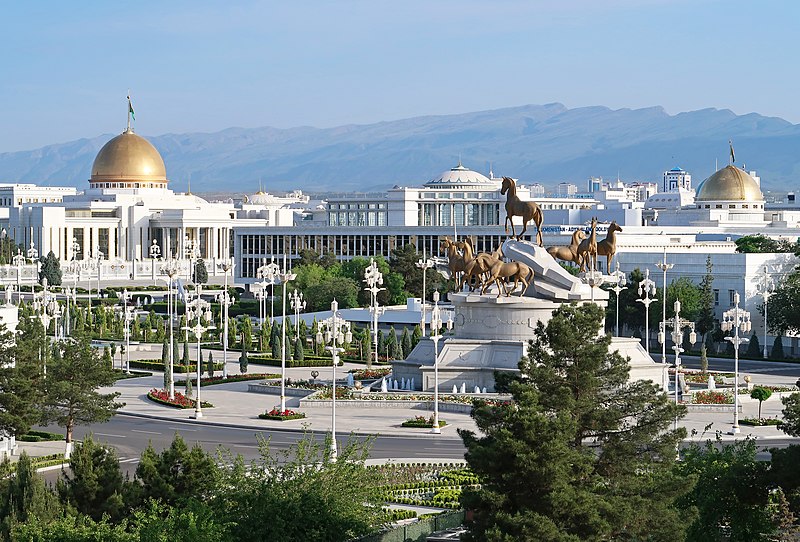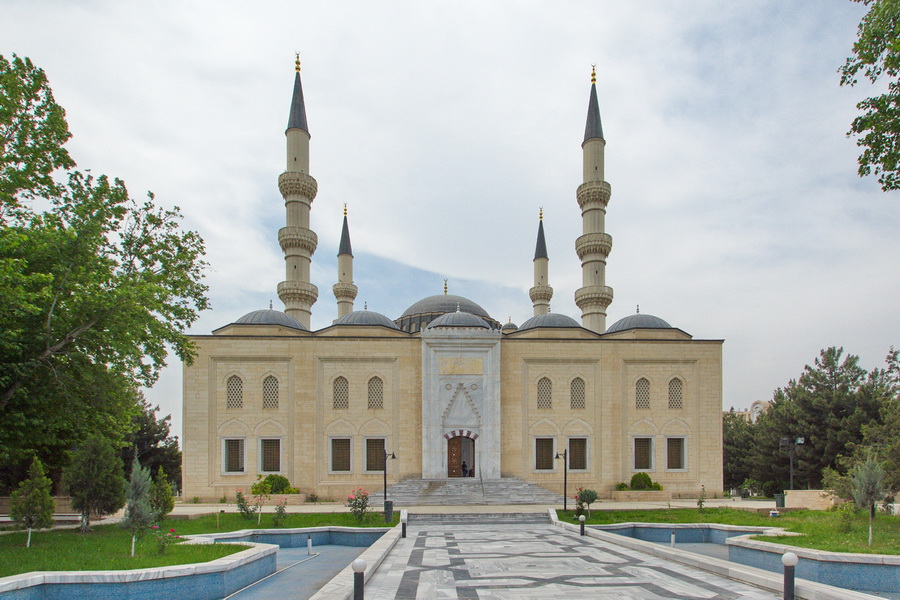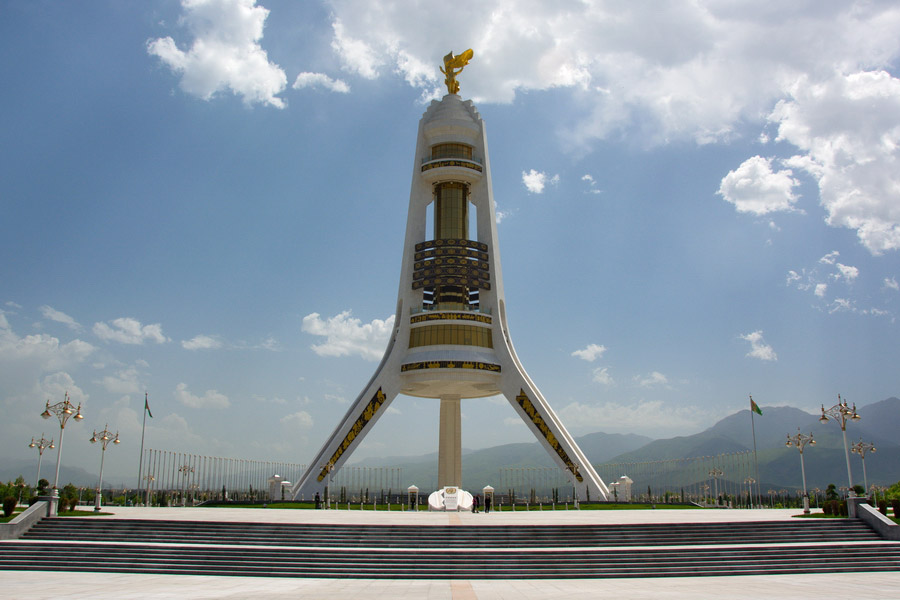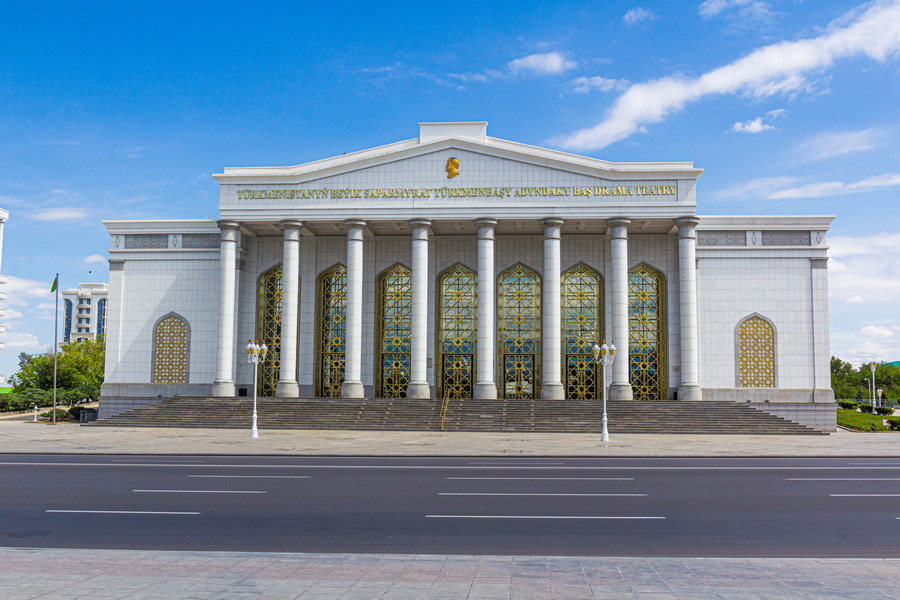
Tour details
- Title: Beatiful Ashgabat
- Continent: Asia
- Cities (Countries): Ashgabat
- Duration:1 (In days)
Details
Ashgabat is the capital of Turkmenistan and the largest city of the country. Divided in four districts or “etraps”, it is also the scientific, administrative, cultural, and industrial center of the republic.
On one side, the city is framed by the Kopetdag Mountain Range and on the other, by the Karakum desert. Located in Central Asia, Ashgabat practically borders Iran – the border is only 25 kilometers away. The climate in the capital is continental extreme, very hot in summer and cool in winter.
Ashgabat has only a few old buildings, since in 1948, a terrible earthquake, destroyed almost everything, taking the lives of more than 175 thousand people.
In 2013, Ashgabat was included in the Guinness Book of Records as the city with highest density of white marble buildings, confirming the title 5 times.
According to official data, in 2018 the number of residents of Ashgabat reached 1 million, while the population of Turkmenistan was a bit more than 6 million people.
History of Ashgabat
On the site of modern Ashgabat, in the 2nd century BC was the city of Konjikala. Konjikala had a strategic location on the Great Silk Road, therefore, was reconstructed even after being destroyed by a great earthquake. The city existed until the 13th century when it was destroyed by the Mongols.
In the 18th century, Russian troops came to this territory and built Askhabad fortress (from the Persian eshq – "love" and abad – "city"). In 1881, a military fortification was founded there and in 1919 became known as Poltoratsk.
After the revolution of 1917, the settlement, which received the status of a city, became the center of the Turkmen region. In 1925 Poltoratsk was proclaimed the capital of the Turkmen ASSR. En 1927, the old name – Askhabad – was given back to the city with the replacement of one letter, and the capital became known as Ashgabat.
In 1991, following the dissolution of the Soviet Union, Turkmenistan gained their independence and Ashgabat became its capital.
What to do in Ashgabat?

Ashgabat greets its visitors with luxurious buildings, numerous fountains, and white marble. Literally all the buildings in the city center, are white!
The city holds many institutions and governmental buildings, unique monuments, attractions and even some Guinness Records awards.
On the list of attractions you can’t miss, we will start with Alem Cultural and Entertainment Center. This center has several museums, and it is famous for the impressive Space Museum and a massive indoor Ferris wheel, which at the time of the opening in 2012, entered in the Guinness Book of Records as the tallest enclosed Ferris wheel in the world.
Ashgabat also holds the main flag of the country, which is flying on a 133-meter-long flagpole. Until 2010, it was considered the tallest in the world and since 2008 counts with a guard of honor.
The Oguzkhan Palace Complex it is the presidential residence. Completed in 2011 was decorated with white marble. Although visitors are not allowed here, you can admire the beautiful exterior of the complex, which is also depicted on the 100 manat banknotes.
In 2010 opened Oguzkent Hotel, a luxury five–star hotel owned by the Government of Turkmenistan. This place boosts a national style decoration, both outside and inside, and of course, white marble.
From the religious buildings, Ertogrulgazy Mosque (Azadi Mosque) stands out for its beauty and for been the largest one in Ashgabat. The mosque is framed by four tall minarets and was built in the Ottoman style, resembling the Blue Mosque in Istanbul.
Built in 1900, Alexander Nevsky Church is the main Orthodox church of Turkmenistan. Its temple is one of the few places surviving the 1948 earthquake. During soviet period, the church was used as a warehouse, but in 1989 the building was returned to the faithful.
A very particular building in Ashgabat is the Wedding Palace Bagt Koshgi, constructed on the shape of an eight-pointed star. This eleven-story building holds in its upper stage, a big golden ball that symbolizes the planet and has an image of Turkmenistan. The complex hosts several rooms of marriage registration, wedding halls, banquet rooms, shops and all necessary for a wedding.
Another interesting site is The Monument of Independence; a 118-meter white column decorated with gilding. The monument is crowned with a crescent moon and five stars, that symbolize the five Turkmen tribes. The bottom of the monument resembles a traditional Turkmen dwelling – a yurt.

The Arch Of Neutrality used to stand on the main square of the country, but in 2011, was moved to Ashgabat’s outskirts. Still worth a visit, this multi-level structure is crowned by a sculpture of the former Turkmenistan´s President, Saparmurat Niyazov. Previously, the sculpture used to rotate after the sun, making a daily full turnover.
Another attraction in the city are their many fountains, which, literally, can be found at every step. One of the most famous is "Oguzkhan and sons" and it entered the Guinness Book of Records as a complex combining many fountains. The complex comprehends the territory of 15 hectares and counts with 27 fountains, symbolizing the peacefulness and unity of the Turkmen people.
At 19 kilometers from the Turkmen capital, are located the ruins of the ancient city of Nisa; a major attraction declared World Heritage Site by UNESCO in 2007. Archaeological excavations have confirmed that Nisa already existed in the 4th- 2nd century BC. Among the ruins it’s possible to identify a ceremonial hall, a round temple, shrines, and mausoleums.
Also, not far from Ashgabat, is located Anau, a city from the end of 5th millennium BC. The city has an eclectic mix of ruins of ancient urban settlements with newer buildings, including the walls of a mosque from the 15th century.
The tallest building in the country, with 211 meters is the TV Tower. The tower is decorated with an octagonal star that entered the Guinness Book of Records, as the largest architectural image of a star. On top of the tower at a height of 154 meters, there is a restaurant that slowly rotates in a circle.
Something particularly interesting in the city, are the telephone booths that can be found on each street. Made with white columns, glass, and gilded ornaments they look like art pieces and each one is different from the other.
Ashgabat Museums

Located in Ashgabat, the main museum of the country is the State Museum of the State Cultural Center of Turkmenistan. Opened in 1998, the complex exposition is divided into 7 thematic galleries that store over 166,000 unique exhibits, many of which are of special historical and cultural importance. The museum has three sections that comprehend natural history, science, and the President of Turkmenistan. The oldest exhibits are from the 6th-2nd millennia BC. The complex includes the Museum of the President of Turkmenistan, the Museum of Ethnography and Local History, the Museum of Independence of Turkmenistan, the Museum of Neutrality, and the Museum of the Constitution of Turkmenistan. Besides, the museum has three branches, all located in Ashgabat: "Galkynysh", "Garashsyzlyk" and "Bitaraplyk".
The Turkmen Carpet Museum was established in 1993 to preserve and develop the traditions of Turkmen carpet weaving. More than two thousand carpets made by hand are awaiting to amaze their visitors. Both ancient and modern carpets are on display here, including one of 301 square meters that entered the Guinness Book of Records as the largest of the world.
The Museum of Fine Arts has 11 halls, exhibiting hundreds of paintings, carpets, sculptures, and precious metals products. An interesting part of the collection is represented by the paintings of Western European artists from the 14th -20th century, and Russian painters from the 18th-20th century.
Located near Ashgabat, it’s the National Museum of Wildlife of Turkmenistan, a modern zoo of 40 hectares with representatives of 250 species of animals, birds, insects, reptiles, and fish.
The National Museum "Ak Bugday" (Museum of White Wheat) is in the suburbs of Ashgabat. This museum, the only of its kind, was built in 1904 on the site where wheat grains of the 3rd century were discovered. Among the exhibits you can also see millstones of the same period, tools from the 3rd-2nd millennia BC and ancient ceramic dishes.
The museum "Sanctity of the Motherland" is located on the territory of the memorial complex "National Memory". It contains exhibits from the World War II and the mid-twentieth century earthquake.
Ashgabat Theatres

The Main Drama Theatre of Turkmenistan is in Ashgabat, and it’s named in honor of president Saparmurat Turkmenbashi. Mainly offers Turkmen playwrights, both classical and modern, all in Turkmen language.
Russian State Drama Theater named after A.S. Pushkin is the only Russian theater in the country. It was established in 1926, and since then, always attracts a lot of viewers.
The Student Theater is popular among young people, as modern plays are staged here.
Another interesting options, are the Turkmen National Youth Theater named after Alp Arslan, the National Musical and Drama Theater named after Makhtumkuli and the Puppet Theater is a great option for the kids.
Delicious Turkmen food

Be sure to try the lamb stewed chekdirme and stuffed bird oytykma. Turkmenistan is also famous for fish dishes, and pilaf with fish and manti with fish are especially good in Ashgabat.
These and other dishes of Turkmen cuisine can be better tasted in the restaurants "Chandybil", Altyn Cynar, "Kopetdag" and Soltan.
Prices per person:
1. 1 person - 290$
2. 2 persons - 190$
3. 3 persons - 170$
4. 4 persons - 145$
Feel free to contact Us if You are interested in this tour